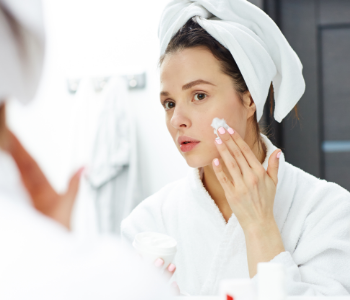Decoding the Texture and your Skincare Regime
Decoding the Texture
> Creams: Usually contain 2 phases—oil phase and water phase. 50-80% by weight of cream has water as the primary component; 15-30% oil, and 6-15% emulsifiers. A typical cold cream is mainly water in oil emulsion. This emulsion contains around 55% mineral oil and 12% beeswax and other ingredients.
> Serums: Formulation which is light, penetrates rapidly, has concentrated actives.
> Lotions: Cleansing creams and lotions are usually detergent-based or emulsified oil systems that are designed primarily for removal of surface oil. Lotions usually contain 15-50% oil with limited quantities of waxy materials.
Decoding your skincare regime
There are a lot of times when patients come to me with no particular concern as such but just to get their routine right. I am often asked, ‘Doc, what are the products you think I should use?’ To this my reply is,‘If you love the product you have been using and it makes your skin feel perfect, say maybe a sunscreen whose consistency you love, then I don’t think there is any reason for you change your brand or the product. If something has suited you so well, you can stick to it for now.’All I then do is play with some actives in terms of correction, if any, and readjust the regime a bit.
The next thing you need to know is how much of your product should you apply, irrespective of what you buy. You could buy the most expensive skincare product on earth or you could buy a tube worth 100 rupees from a medical store which probably has the same ingredients in it as the expensive product, but the results on the skin will depend on how effectively you apply it.
> How to apply
Do not rub the cream/ lotion on to your palms and then on your face! That is a big no no. Take a bit on your fingertip and then apply it on your skin. After this, gently spread it across your face with just two fingers. I am often asked about how much of any skincare product really permeates our skin. You must know that the external layer of the skin, the epidermis, is technically a dead skin layer which is made of keratin, a protein that tightly adheres to each other. Therefore, it is impossible for any external thing to permeate your skin unless the molecule is of a special size or has some important ingredients which can take the heavier molecules along with it inside. So it’s important for us to first:
> Cleanse the skin so that the oil of the skin is out of the way and it doesn’t block the creams.
> Exfoliate once in a while to make sure that the dead skin is gone. You can go to your skin doctor for chemical peeling or hydra peeling to remove the top dead layer.
> How much to apply
How much of a particular product you should apply depends on the skin issue that you are dealing with. For example, if the skin is super dry and you are looking for a moisturizer, I would then say definitely douche your skin with enough quantity of the product and after 2-3 hours, you will see that it makes a lot of difference.
But if you are using an active ingredient, like say for acne or for pigmentation or for any specific condition on your skin, then using a lot might further irritate or sometimes make it worse. Start off with a very thin layer, feathering it into your sensitive areas. If your product has active ingredients like acids, then always remember that less is good to start with.
> When to apply
Use anti -ageing/skin lightening treatment products usually at night. Sunscreens in the sun up hours. Never mind if you are indoors or whether it is a cloudy, rainy, or a windy day.
> How long to keep it on your skin
Some overnight, some for long hours, and some for just a couple of hours, depending upon your skin doctor’s instructions. However, sunscreens have to be reapplied every 4 hours. Ask your doctor these questions when you consult him/her.
By and large, if you keep any product for 2 hours to start with, it will give you an idea about how strong it is, or how well your skin takes it. You will know whether keeping it on for longer makes your skin go red, or too dry, or itchy. You will know all this after keeping it on for two hours for the first time and then removing it. Once your skin settles with the product, you could increase it to overnight application. However, if you are using something more nourishing or replenishing like vitamin creams, antioxidants, or simply moisturizers, then go ahead and be liberal and keep it as long as you want to.
WHEN YOU APPLY A CREAM, SERUM, OR LOTION (CLEANSER, SUNSCREEN, OR NIGHT CREAM), DO IT ON YOUR FACE WITH A FINGER AND WITH TWO FLAT FINGERS, SPREAD THE CREAM ALL OVER WITH FIRM STROKES.
Maximise your potion
The most common question asked in any skincare talk that I have given so far is in which order should one apply one’s skincare creams. There’s a perpetual confusion as to sunscreen first or sunscreen last and when does the serum go on. So let me try and make it easy for you.
In the right order
> Corrective or a therapeutic agent goes first i.e. right on your skin. It could be anti-ageing, anti- acne, anti-pigmentation—any one of these.
> Nourisher comes next, and it could be a cream or any form of hydrant.
> The protectant—sunscreen—goes on top.
> Coloured make up tops it all.
The right delivery medium
> Serums and gels go first.
> Creams and lotions go next.
> Oils, silicones, and petroleum jellies go on top.
Because once you apply these nothing else ever penetrates.
How to get a clean face
> Remove make up first:
Intensely pigmented make up—which is usually the eye, eyebrow, and lip make up—needs to be removed first. After you have gotten rid of this, use the make up remover for the rest of your face and neck. Always use separate cotton for each area. Using wrong strokes and harsh product to remove the eye make up may lead to loosening of skin in that area, so do it carefully. This can burst the tiny capillaries and cause blood cells to get accumulated which make the eye and under eye area look dark.
> Cleanse it right: Wash your face with slightly warm water, running it over for more than a minute. Keep dabbing warm water because it softens the face and makes it more receptive. Then wipe the water and use a cream cleanser. Gently keep going round and round all over the areas that you want to cleanse. Wipe it off with wet cotton so that your face is absolutely devoid of any dirt and grime you might have collected during the day.
> Wash away: Your final step for clean skin is washing with a face wash. It removes the grime and you skin looks fresh. Take a little on your fingertips and lather, then apply all over your face, neck, and décolletage. Wash off with cold or lukewarm water depending on the weather.
When all you have and want is a pot of cream
A lot of my patients come to me with a list of concerns, and some want me to wave a magic wand! They tell me they hate to eat pills and have no patience for 10 creams…so they give me a list of what they are willing to NOT do as well.
If you are that type, let me first THANK YOU for even picking my book. And now, here’s how I am going to make it all so easy for you.
Get your skin type right and then pick that one cream or lotion that suits your skin type well. So if you have oily skin, pick a lotion; if you have dry skin or mature skin, pick a pot of cream. Whatever brand it may be—it can be from La Prairie to Pond’s cold cream, whatever your pocket fancies—just pick one cream.
As I have already told you, there are three things you have to do in your skincare regime—cleansing, moisturizing, and protection. Here’s what you can do with one pot or bottle of potion
Remove make up: Apply the eye and lip make up, leave it on for a minute, take a warm wet cotton, and wipe it off gently. Then wipe the rest of your face and neck. No matter how much the make up, it will loosen and come off.
Exfoliate: Mix a spoonful of sugar into the lotion and apply it on your face. This acts as a gentle scrub and removes all the top dead skin cells.
You will, of course, need a face wash to wash away the residue.
> As a face mask: After you have washed your face, if your skin feels dehydrated, apply a slightly thicker layer of the same cream as a face mask. Take a muslin cloth, soak it wet, and apply it over your face for 5 to 10 minutes. Rinse it off and wipe the residue. This soaks the cream really well into your skin, making it feel plump and hydrated. By doing this, your cream will behave almost like an anti-ageing cream.
> As a sunscreen: Mix the cream with your make up foundation or calamine lotion and apply it on top. This will act as your sunscreen. The titanium dioxide, a sun block, is what makes these creams opaque. So that itself provides you sunscreen of about 15 SPF. This is better than anything.
> As a night cream: Put some lemon juice into the cream if you need skin lightening/pore reduction and apply it thoroughly. You can also mix a few drops of essential oils like lavender if you need more hydration and have a mature skin. Put chamomile if you need calming.
> Hydrant: On the days when you feel not so dry but dehydrated, wet you face slightly and apply the cream on damp skin. That acts as a moisture sealant, keeping moisture intact on the days you feel dehydrated.
> Eye and lip care: Make sure you apply cream as a thick layer under your eyes and over your lips when you go to bed, so that in the morning, these areas look nice and plump.
So there you go, with just one cream, you can pretty much achieve everything you want to.
Leave a Reply
Want to join the discussion?Feel free to contribute!













Really enjoyed this post, how can I make is so that I get an update sent in an email every time there is a new update?
You can follow Dr. Rashmi Shetty on social media to stay updated.